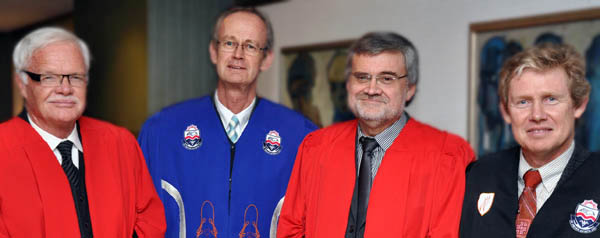 |
At the DF Malherbe Memorial Lecture, from the left: Prof. Hennie van Coller, Head of the Department of Afrikaans and Dutch, German and French; Prof. Teuns Verschoor, Vice-Rector: Institutional Affairs; Prof. Wannie Carstens; and Prof. Lucius Botes, Dean of the Faculty of the Humanities.
Photo: Stephen Collett
07 June 2012 |
- Lecture (pdf format - only available in afrikaans)
Does Afrikaans have a future in South Africa? How will the language become a truly transformed language of the new South Africa given the baggage of the image as the language of the oppressor? Will Afrikaans eventually die out?
These were the questions asked by Prof. Wannie Carstens, Director of the School of Languages at the Potchefstroom Campus of the North-West University, when he recently delivered the 31st DF Malherbe Memorial Lecture at the Bloemfontein Campus of the University of the Free State (UFS).
Prof. Carstens, also the former Chairperson of the Afrikaans Language Board, wanted to know whether reconciliation in Afrikaans is feasible, referring to the history of Afrikaans in South African politics. In a reference to the 1976 Soweto riots, he said a language could not be blamed for the mistakes of some of its speakers.
"The time is probably ripe to put this past behind us so that we can go on to reflect on Afrikaans, and in particular, the role of the Afrikaans speaker in the South Africa of 2012, and on the Afrikaans of 2060."
According to Prof. Carstens, an important condition for the reconciliation process of Afrikaans is to depoliticise the language. He referred to work that is being done by the Afrikaans Language Board and asked that everyone contribute to healing the Afrikaans language community.
"Let work together on a voice that can claim that it speaks on behalf of Afrikaans, and that might be able to contribute in the interest of Afrikaans to a truly transformed Afrikaans, or rather an inclusive Afrikaans that provides for all its speakers. When we are able to say that all Afrikaans voices are represented, only then can we truly talk of a transformed Afrikaans community."